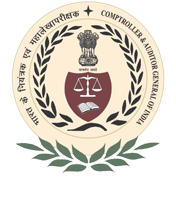Audit Reports

Jharkhand
Report No. 3 of 2022 - Report of the C&AG on Implementation of Rural Electrification schemes in Jharkhand for the year ended 31 March 2020
Overview
The Audit Report of the Comptroller and Auditor General of India on Implementation of Rural Electrification schemes in Jharkhand, Government of Jharkhand, for the year ended 31 March 2020, prepared under Article 151 of the Constitution of India, was submitted to the Governor of Jharkhand on 27 June 2022. The report was presented to the State Legislature on 4 August 2022.
The Government of India and the State Governments have been implementing several rural electrification schemes with the objective of closing the gap between urban and rural areas with respect to availability of power viz., Deen Dayal Upadhyaya Gram Jyoti Yojana (DDUGJY), Rajiv Gandhi Grameen Vidyutikaran Yojana (RGGVY), Pradhan Mantri Sahaj Har Ghar Bijali Yojana (SAUBHAGYA), Atal Gram Jyoti Yojana (AGJY), Tilka Manjhi Krishi Pump Yojana (TMKPY) and Jharkhand Sampurna Bijli Aachhadan Yojana (JSBAY).
The Performance Audit on Implementation of Rural Electrification Schemes in Jharkhand, covering the period 2015-20, was carried out during the year 2019-20, with the objective of assessing the implementation of rural electrification schemes in the State.
Planning
Jharkhand Bijli Vitran Nigam Ltd. (JBVNL) did not maintain database regarding status of electrification of villages except consumer database. While conducting field survey in the seven test-checked districts before commencing the electrification works, the Turnkey Contractors (TKCs) found that 260 electrified villages and 678 non-existent villages were included in the DPRs.
JBVNL was deprived of GoI grant amounting to ₹ 182.68 crore due to non-completion of RGGVY (X FYP) in Chatra, Garhwa, Latehar and Palamu districts, non-pursuance by JBVNL regarding electrification of left out BPL households in Dumka and West Singhbhum districts and non-uploading of DPR of Simdega district.
Village and Household electrification
Though the targets to complete electrification measures in the seven test-checked districts were fixed between July 2019 and December 2019, electrification of 819 (10 per cent) out of 7,925 villages taken up under DDUGJY was not completed as of March 2020. Further, 23,951 (21 per cent) out of 1,15,629 connections and 68,417 (32 per cent) out of 2,15,605 connections could not be provided as of March 2020 under RGGVY (XII FYP) and DDUGJY respectively on account of various project bottlenecks.
AGJY was fore-closed after providing free electric connections to 1.86 lakh APL households against the target of 3.64 lakh APL households as JBVNL could not provide list of beneficiaries to the Turnkey Contractors (TKCs).
JBVNL incurred an avoidable expenditure of ₹ 15.85 crore as 56,954 APL connections were released free of cost under DDUGJY against the norms.
Under SAUBHAGYA, 2,84,485 connections were released in the seven test-checked districts against work order for providing 4,06,196 connections without ensuring assessment of beneficiaries eligible for free connections.
Though the Department had set a target of providing 3.04 lakh agriculture connections under TMKPY in April 2015, no application for agriculture connections were received from farmers under the scheme mainly due to scarcity of water in nearby water bodies for carrying out irrigation. The scheme was closed in October 2018 without releasing any connections.
Out of total 5,23,295 connections released under centrally sponsored schemes in the seven test-checked districts, only 2,93,334 consumers were being billed.
Scrutiny of 431 consumers revealed that billing was started with delays ranging between two to 27 months from the date of release of the connections. Further, scrutiny of energy bills of 200 unmetered/defective meter consumers whose meters had been replaced, revealed that 182 consumers were being billed on average basis even after a lapse of eight to 23 months after replacement of the meters.
Collection of energy charges from rural consumers was 15.46 and 13.98 per cent under DS-I(A) tariff1 and 46.77 and 38.81 per cent under DS-I (B) tariff2 during 2018-19 and 2019-20 respectively excluding subsidy received from GoJ. This, when compared with the overall collection efficiency (between 85 and 90 per cent) of JBVNL, was poor.
JBVNL could not achieve the targeted Aggregated Technical & Commercial (AT&C) loss of 15 per cent by 2018-19 as envisaged under Ujjwal Discom Assurance Yojana (UDAY) and the AT&C loss during 2019-20 was 33.49 per cent. As a result of the failure to keep AT&C loss within the limits fixed by Ministry of Power (MoP), JBVNL would not be able to avail the opportunity of conversion of loan component into grant under DDUGJY.
Separation of Feeders
Although 47 feeders and 1,981.29 Ckms of agricultural electric lines were erected as a part of separation of agriculture feeders, none of these were charged. Out of these, 40 feeders and 1,840.71 Ckm of agricultural lines were not put to use even after installation of 2,966 Dtrs in Deoghar, Dhanbad and Ranchi districts at a cost of ₹ 90.61 crore for agriculture connections though 16,406 agriculture consumers already existed in these districts.
Strengthening of Sub-transmission and Distribution network
Under DDUGJY, 29 Power Sub Stations (PSSs) of 235 Mega Volt Ampere (MVA) were constructed. Of these, only eight PSSs of 70 MVA could be charged while 21 PSSs were idle (June 2020) even after three to 29 months of their construction mainly due to the associated Grid Sub Stations (GSSs) remaining incomplete (three cases), non-erection of required 33 or 11 KV lines (16 cases) besides absence of trained manpower (two cases) to operate these PSSs.
JBVNL had not installed energy meters at PSSs and feeders constructed. Though energy meters were installed at Distribution Transformers (DTrs), DTr-wise energy accounting was not being carried out to check the losses. Thus, one of the main objective i.e., reducing AT&C losses was defeated.
Financial Management
JBVNL had not ensured timely completion of works related to RGGVY (XII FYP) resulting in avoidable expenditure of ₹ 3.43 crore incurred towards charges paid to Project Monitoring Agency (PMA) upto September 2020.
JBVNL failed to complete works within stipulated time, keep AT&C losses within the prescribed limit of 15 per cent by 2018-19 and claim admissible revenue subsidy from GoJ in the absence of metered and billed power consumption. Thus, JBVNL would not be able to avail the benefit of conversion of 50 per cent of loan valued at ₹ 558.32 crore into additional grant.
Contract Management
Eighteen packages were awarded to six agencies to carry out rural electrification works. None of the agencies met the required technical criteria to qualify for the bids. Further, in 304 test-checked cases, there were instances of non-deduction of royalty, delays in execution of agreements, empanelment of vendors without calling open tenders and violation of Delegation of Financial Powers (DoFP) in awarding contracts/works.
Monitoring
District Electric Committees (DECs) were to meet once in three months to review the quality of power supply, consumer satisfaction and to promote energy efficiency and energy conservation. In the seven test-checked districts, DECs met only once against the requirement of 20 meetings during April 2015 to March 2020 for which no reasons were available on record. Thus, supervisory oversight by DECs, as laid down in the scheme guidelines, was absent.
1 Domestic rural BPL consumers are classified as DS 1(A) as per JSERC tariff
2 Domestic rural consumers other than BPL are classified as DS 1(B) as per JSERC tariff
Download Audit Report
-
Report No. 3 of 2022 - Report of the C&AG on Implementation of Rural Electrification schemes in Jharkhand for the year ended 31 March 2020
 (2.22 MB)
Download
(2.22 MB)
Download
-
Cover Page
 (0.03 MB)
Download
(0.03 MB)
Download
-
Table of Contents
 (0.04 MB)
Download
(0.04 MB)
Download
-
Preface
 (0.04 MB)
Download
(0.04 MB)
Download
-
Executive Summary
 (0.08 MB)
Download
(0.08 MB)
Download
-
Chapter 1
 (0.10 MB)
Download
(0.10 MB)
Download
-
Chapter 2
 (0.10 MB)
Download
(0.10 MB)
Download
-
Chapter 3
 (0.16 MB)
Download
(0.16 MB)
Download
-
Chapter 4
 (0.08 MB)
Download
(0.08 MB)
Download
-
Chapter 5
 (0.91 MB)
Download
(0.91 MB)
Download
-
Chapter 6
 (0.11 MB)
Download
(0.11 MB)
Download
-
Chapter 7
 (0.16 MB)
Download
(0.16 MB)
Download
-
Chapter 8
 (0.07 MB)
Download
(0.07 MB)
Download
-
Chapter 9
 (0.06 MB)
Download
(0.06 MB)
Download
-
Appendices
 (0.33 MB)
Download
(0.33 MB)
Download

